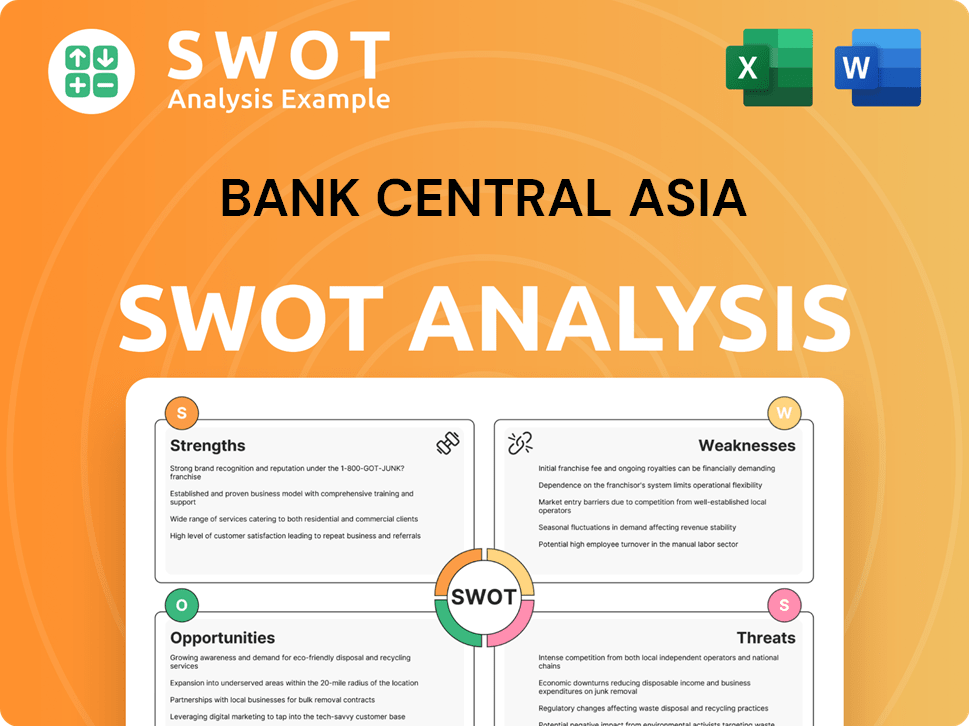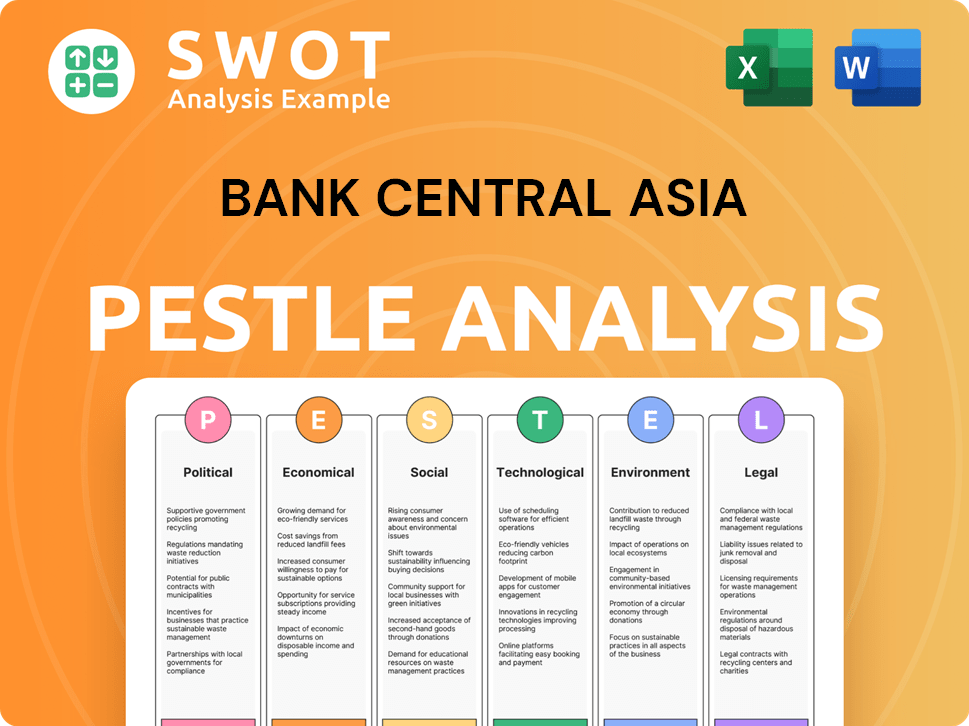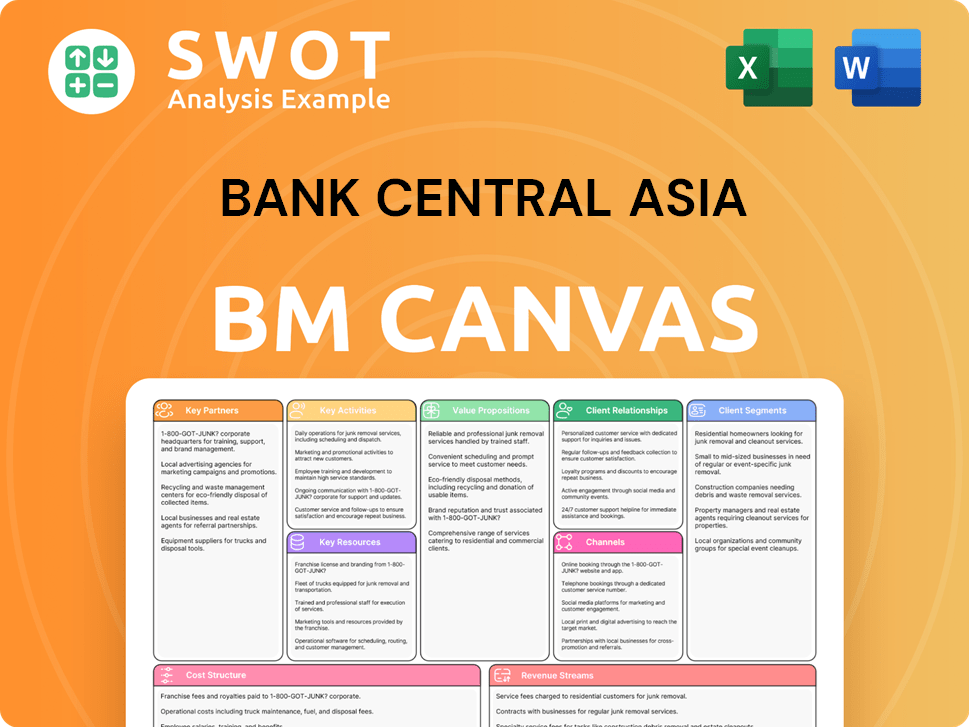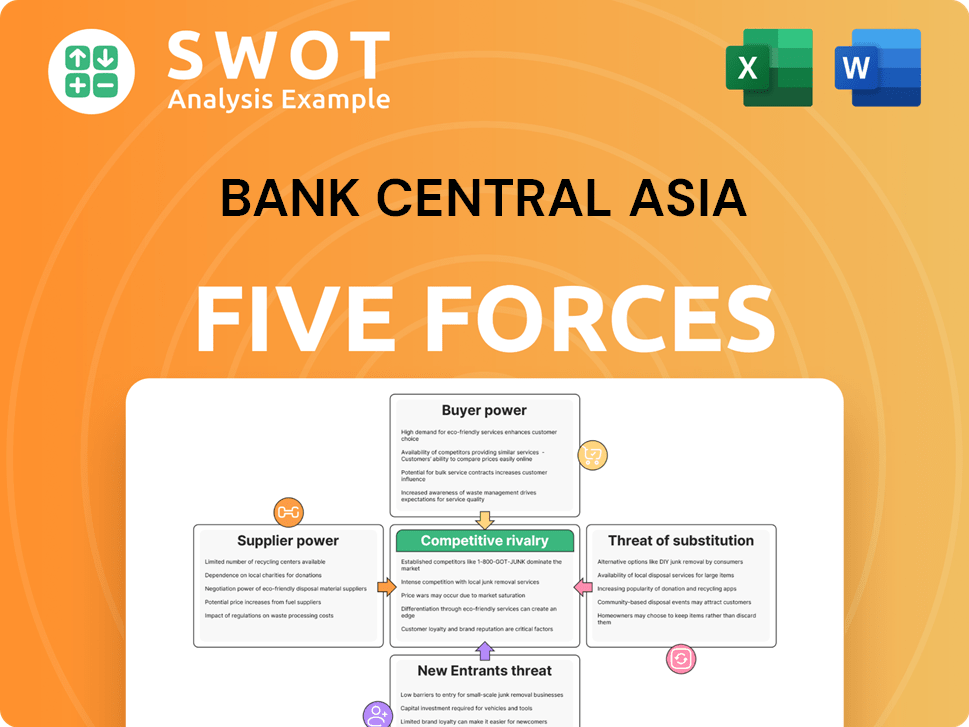Bank Central Asia Bundle
How Does Bank Central Asia Thrive in Indonesia's Banking Sector?
Bank Central Asia (BCA), a leading Indonesian bank, isn't just big; it's a powerhouse. As the largest bank by market capitalization on the Jakarta Composite Index (JCI), BCA's influence is undeniable. With a market cap exceeding IDR 1,076 trillion as of 2024, understanding Bank Central Asia SWOT Analysis is crucial for investors, customers, and industry watchers alike.

BCA's impressive financial performance, including a 9.8% year-on-year net profit growth to IDR 14.1 trillion in the first quarter of 2025, underscores its robust business model. This Indonesian bank offers a comprehensive suite of banking services, from innovative digital solutions to traditional offerings, catering to a diverse clientele. Exploring BCA's operational framework reveals insights into its revenue streams, strategic initiatives, and competitive advantages within the dynamic financial institution landscape.
What Are the Key Operations Driving Bank Central Asia’s Success?
The core operations of the Bank Central Asia (BCA) revolve around delivering a comprehensive suite of financial services to a diverse customer base, including individuals, small and medium-sized enterprises (SMEs), and corporations. These services encompass deposit accounts, loans, credit cards, wealth management, and a wide range of digital banking solutions. BCA's value proposition is rooted in its robust transaction banking franchise, which provides a competitive edge in funding costs, thanks to its high Current Account Savings Account (CASA) ratio.
As of March 2025, BCA's CASA funds increased by 8.3% year-over-year to Rp979 trillion, accounting for 82% of total third-party funds (DPK). This strong foundation allows BCA to maintain a stable and cost-effective funding base, supporting its lending activities and overall financial performance. This strategic advantage is critical in a competitive banking environment, enabling BCA to offer attractive rates and services to its customers.
BCA's operational model combines an extensive physical network with advanced digital banking services. This 'hybrid' approach ensures broad accessibility and convenience for its vast customer base, which exceeded 33 million customers as of December 2024, and more than 40 million customer accounts by September 2024. The bank's commitment to both physical and digital channels allows it to cater to a wide range of customer preferences, ensuring that all customers can access services easily.
BCA's digital platforms, such as BCA Mobile and myBCA, are central to its service delivery, facilitating billions of transactions annually. Mobile and internet banking transaction frequency reached 23 billion in the first nine months of 2024, growing 24% year-over-year. These platforms offer a wide range of features, including fund transfers, bill payments, and account management.
BCA focuses on customer trust and innovation, especially in digital banking. New features like 'BagiBagi' on myBCA allow customers to share money up to Rp50 million per day with multiple recipients, and QRIS TAP for NFC-enabled Android users, further enhancing digital convenience. These innovations improve user experience and encourage digital adoption.
BCA integrates ESG (Environmental, Social, and Governance) principles into its lending decisions. Credit to sustainable sectors increased by 19% YoY to Rp235 trillion as of March 2025, representing 25% of its total financing portfolio. This proactive approach to sustainable finance aligns with evolving market demands and differentiates BCA from competitors.
BCA strengthens its supply chain and distribution networks through strategic partnerships. BCA Digital (blu by BCA Digital) collaborates with platforms like Blibli, MRT Jakarta, and Garuda Indonesia, enabling seamless integration of banking services into partner applications. These partnerships expand BCA's reach and enhance customer convenience.
BCA's operational efficiency is evident in its well-managed cost-to-income ratio, which was 28.5% in Q1 2025. The bank's extensive network includes over 1,260 branches and 19,439 ATMs, ensuring broad accessibility. BCA's focus on customer trust and innovation drives its success in the Indonesian banking market.
- Strong CASA Ratio: High CASA ratio provides a stable funding base.
- Digital Innovation: Continuous enhancements to mobile and online banking platforms.
- Sustainability Focus: Commitment to ESG principles in lending practices.
- Strategic Partnerships: Collaborations to expand service offerings and reach.
Bank Central Asia SWOT Analysis
- Complete SWOT Breakdown
- Fully Customizable
- Editable in Excel & Word
- Professional Formatting
- Investor-Ready Format

How Does Bank Central Asia Make Money?
Bank Central Asia (BCA) generates revenue through a diverse range of financial services, primarily focusing on net interest income and non-interest income. The company's robust performance is driven by strategic loan growth and innovative digital banking solutions. This approach allows BCA to maintain its strong position in the Indonesian banking sector.
The company's monetization strategies are centered on leveraging its substantial Current Account Savings Account (CASA) base and expanding its digital ecosystem. These strategies are designed to enhance profitability and provide value to its customers. BCA continues to adapt and innovate to meet the evolving needs of its customers and the market.
BCA's revenue streams are primarily fueled by net interest income (NII) and non-interest income. In the first quarter of 2025, BCA's NII increased by 7.1% year-on-year (YoY) to Rp21.1 trillion. This growth was supported by a rise in loan yields and a 12.6% YoY loan expansion, with significant contributions from corporate, commercial, SME, and consumer segments. As of March 2025, total loans reached Rp941 trillion.
Non-interest income also plays a critical role, increasing by 8.1% YoY to Rp6.8 trillion in Q1 2025. This includes fee and commission income, which saw a 7.0% YoY increase in the first nine months of 2024. The digital banking platform, blu by BCA Digital, significantly contributes to the group's growth, with its operational income rising by 70% in 2024.
- Net Interest Income (NII): The primary revenue source, driven by interest earned on loans.
- Non-Interest Income: Includes fees and commissions from various banking services.
- Digital Banking: blu by BCA Digital contributes substantially to operational income.
BCA's monetization strategies are focused on leveraging its strong CASA franchise, which stood at 82% as of March 2025, providing a low cost of funds and enhancing the net interest margin (NIM). The projected NIM for 2025 is 5.9%, up from 5.8% in FY24. The bank also employs value chain financing and partnerships to drive loan growth, and its digital ecosystem facilitates high transaction volumes, generating significant fee-based income. For more insights, you can explore the Growth Strategy of Bank Central Asia.
BCA's success is also fueled by its focus on sustainable sectors, with loans in these sectors increasing by 19% YoY to Rp235 trillion by March 2025, representing 25% of its total financing portfolio. This includes a notable surge in electric vehicle loans, which climbed 84.2% to Rp2.3 trillion in 2024.
- CASA Optimization: Leveraging a high CASA ratio to reduce funding costs.
- Value Chain Financing: Strategic partnerships to boost loan growth.
- Digital Ecosystem: High transaction volumes driving fee income.
- Sustainable Sector Growth: Expanding loans in sustainable sectors.
Bank Central Asia PESTLE Analysis
- Covers All 6 PESTLE Categories
- No Research Needed – Save Hours of Work
- Built by Experts, Trusted by Consultants
- Instant Download, Ready to Use
- 100% Editable, Fully Customizable

Which Strategic Decisions Have Shaped Bank Central Asia’s Business Model?
Bank Central Asia (BCA) has strategically positioned itself as a leader in the Indonesian banking sector. Key to its success are the strategic moves and milestones that have shaped its operations. This includes a strong emphasis on digital banking solutions and maintaining robust asset quality.
The company's focus on customer convenience is evident in its continuous upgrades to the myBCA application. This includes features like 'BagiBagi' for money sharing and QRIS TAP for NFC users. BCA also introduced an Investment Goals feature in myBCA for easier planning of various investment goals, and online account opening for Indonesian citizens residing abroad using overseas mobile numbers. BCA’s partnership with BAZNAS and Lazismu under PP Muhammadiyah in Q1 2025 further demonstrates its adaptation to market needs.
Operationally, BCA's commitment to financial health is clear. The bank maintains a low loan at risk (LAR) ratio of 6% and a non-performing loan (NPL) ratio of 2% as of Q1 2025. These figures highlight BCA's strong asset quality. BCA's credit to sustainable sectors grew by 9.3% year-on-year to IDR 198 trillion as of June 2024, accounting for 23.2% of its total loan portfolio. This includes a financing ban on environmentally damaging industries like coal mining and palm oil.
BCA's journey includes significant milestones, such as the continuous improvement of its digital banking platform, myBCA. The introduction of new features and services like 'BagiBagi' and QRIS TAP highlights its dedication to enhancing customer experience. BCA also introduced an Investment Goals feature in myBCA for easier planning of various investment goals, and online account opening for Indonesian citizens residing abroad using overseas mobile numbers. The partnership with BAZNAS and Lazismu under PP Muhammadiyah in Q1 2025 to offer convenient zakat, infaq, and sadaqah services via myBCA further demonstrates its strategic adaptation to market needs.
Strategic moves by BCA include a strong focus on sustainable finance. The bank has increased its credit to sustainable sectors. BCA has also banned financing for environmentally damaging industries. BCA continues to adapt to new trends by focusing on growth opportunities in SME and consumer sectors, particularly in downstream industries and renewable energy, while strengthening the integration between online and offline channels to boost CASA.
BCA's competitive edge is built on its strong brand, technological leadership, and economies of scale. The bank was recognized as the World's Strongest Banking Brand 2025. Its high Current Account Savings Account (CASA) ratio, which was 82% in Q1 2025, provides a stable funding base. The bank's consistent growth in transaction volume, reaching 36 billion transactions in 2024, further solidifies its position as a dominant transaction bank.
BCA's financial performance is supported by strong asset quality, with a low LAR and NPL ratio. The bank's focus on sustainable finance and its high CASA ratio contribute to its profitability. For more insights into BCA's growth strategy, consider reading about the Growth Strategy of Bank Central Asia.
BCA's success is underpinned by several key advantages that distinguish it in the Indonesian banking landscape.
- Strong Brand Recognition: BCA has a well-established brand, recognized globally.
- Technological Leadership: The bank's investment in technology has led to innovative digital banking solutions.
- Economies of Scale: BCA's large customer base and extensive network allow it to operate efficiently.
- Robust Financial Health: High CASA ratio and low NPL ratios contribute to its financial stability.
Bank Central Asia Business Model Canvas
- Complete 9-Block Business Model Canvas
- Effortlessly Communicate Your Business Strategy
- Investor-Ready BMC Format
- 100% Editable and Customizable
- Clear and Structured Layout

How Is Bank Central Asia Positioning Itself for Continued Success?
Bank Central Asia (BCA) maintains a leading position in the Indonesian banking sector. It consistently holds the largest market capitalization on the Jakarta Composite Index (JCI). Its strong customer base and high Current Account Savings Account (CASA) ratio highlight its competitive advantage in funding costs.
Despite its strong market position, BCA faces several risks, including potential rises in Non-Performing Loans (NPLs) and declines in Net Interest Margin (NIM). External factors such as geopolitical uncertainties and regulatory changes also pose challenges. The bank must continuously adapt to technological disruptions and new competitors.
BCA is the largest Indonesian bank by market capitalization, reaching IDR 1,076 trillion as of 2024. It serves over 33 million customers as of December 2024, with over 40 million customer accounts by September 2024. Its CASA ratio is 82%, significantly above the sector average.
Key risks include potential increases in NPLs, which were 1.8% in 2024, and NIM declines. Geopolitical uncertainties and regulatory changes are also significant challenges. New competitors and technological disruptions require ongoing adaptation.
BCA plans to focus on growth in the SME and consumer sectors, particularly in downstream industries and renewable energy. It aims to boost CASA and cautiously raise loan yields. For 2025, BCA anticipates moderate loan growth of 7-8%.
BCA is committed to ESG principles, improving data quality for climate risk responses. It aims to strengthen its ecosystem and online/offline channel integration. BCA's Q1 2025 net profit grew by 9.8% to Rp14.1 trillion, with a strong CAR of 29.3% by FY24.
BCA's strong financial performance, including its net profit growth, positions it well for continued success. The bank's strategic focus on the SME and consumer sectors, coupled with its commitment to ESG, supports sustainable growth. To understand the target market of this financial institution, explore the details in this article: Target Market of Bank Central Asia.
- Dominant market share in the Indonesian banking sector.
- Focus on SME and consumer sectors for growth.
- Commitment to ESG principles and sustainable practices.
- Strong financial health with a high CAR.
Bank Central Asia Porter's Five Forces Analysis
- Covers All 5 Competitive Forces in Detail
- Structured for Consultants, Students, and Founders
- 100% Editable in Microsoft Word & Excel
- Instant Digital Download – Use Immediately
- Compatible with Mac & PC – Fully Unlocked

Related Blogs
- What are Mission Vision & Core Values of Bank Central Asia Company?
- What is Competitive Landscape of Bank Central Asia Company?
- What is Growth Strategy and Future Prospects of Bank Central Asia Company?
- What is Sales and Marketing Strategy of Bank Central Asia Company?
- What is Brief History of Bank Central Asia Company?
- Who Owns Bank Central Asia Company?
- What is Customer Demographics and Target Market of Bank Central Asia Company?
Disclaimer
All information, articles, and product details provided on this website are for general informational and educational purposes only. We do not claim any ownership over, nor do we intend to infringe upon, any trademarks, copyrights, logos, brand names, or other intellectual property mentioned or depicted on this site. Such intellectual property remains the property of its respective owners, and any references here are made solely for identification or informational purposes, without implying any affiliation, endorsement, or partnership.
We make no representations or warranties, express or implied, regarding the accuracy, completeness, or suitability of any content or products presented. Nothing on this website should be construed as legal, tax, investment, financial, medical, or other professional advice. In addition, no part of this site—including articles or product references—constitutes a solicitation, recommendation, endorsement, advertisement, or offer to buy or sell any securities, franchises, or other financial instruments, particularly in jurisdictions where such activity would be unlawful.
All content is of a general nature and may not address the specific circumstances of any individual or entity. It is not a substitute for professional advice or services. Any actions you take based on the information provided here are strictly at your own risk. You accept full responsibility for any decisions or outcomes arising from your use of this website and agree to release us from any liability in connection with your use of, or reliance upon, the content or products found herein.